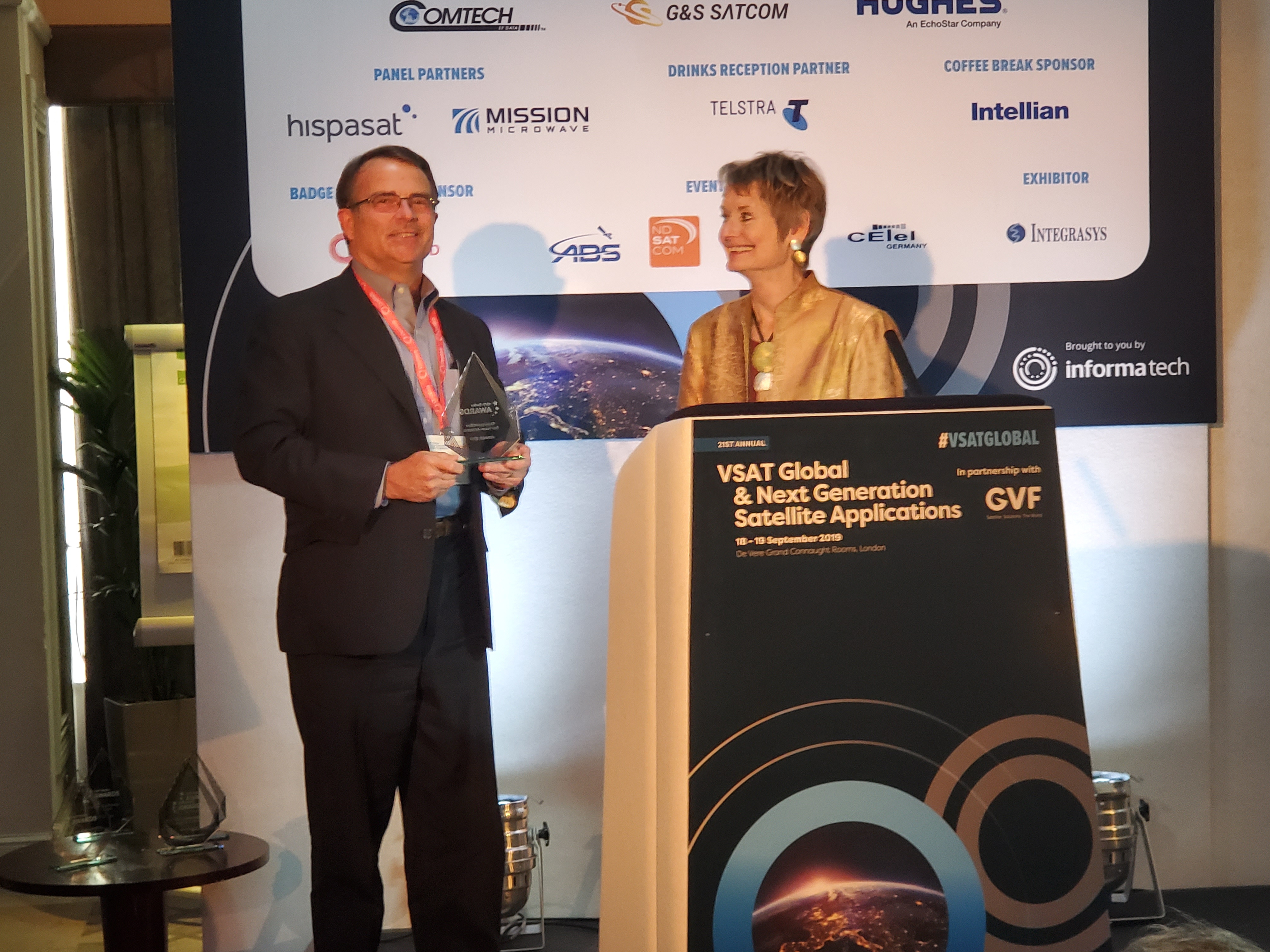The recurring themes running through the three European Conferences (World Satellite Business Week in Paris, IBC in Amsterdam and VSAT and Next Generation Satellite Applications in London) durig the month of September, were the need for flexibility and the Low Earth Orbit (LEO) constellations.
Flexibility in manufacturing and flexibility in service offerings.
In panels at World Satellite Business Week (WSBW), all the satellite manufacturers talked about the need to make satellites more flexible. Paul Gaske, EVP and General Manager Hughes North America, pointed out that “with flexibility there are so many business cases that can be proved out, which is good for the manufacturers as they can use the results of one set of Research and Development many times, instead of having to repeat for every customer.” From the manufacturers side, Chris Johnson, President, Boeing Satellite Systems International, talked about the 702x product line which was announced on the eve of WSBW. The 702x is a further development of the software defined satellites that Boeing developed for SES for its mPower constellation. mPower is a Medium Earth Orbit (MEO) constellation. The 702x extends the flexibility offered by software defined satellites to the geostationary arc and allows operators to dynamically allocate bandwidth to respond to changing market conditions. The 702x can be delivered in three years.
Jean-Loic Galle, President Thales Alenia Space, talked about the need for both flexibility and power, and speed to market; it is planned that the production lead time for a standard satellite will be be decreased by a factor of two. However it was also mentioned that there will always be some customers that require a specialized satellite, so Thales Alenia will maintain a specialized as well as standardized product line.
Pierre Francois Delval, Head of Innovation, Advanced Projects and Proposals, Telecommunication Satellites, Airbus Defence and Space, disagreed slightly saying that he felt that flexibility per se, was not so important. “What is important is to allow customers to adapt to emerging markets, test them and change markets if necessary. DTH to broadband for example.” He also pointed out that Airbus had been able to adapt their experience in airline manufacturing to satellite manufacturing, particularly with reference to the OneWeb satellites. Guy Beutelschies, VP Communication Satellite Solutions, Lockheed Martin, agreed about the need for on-orbit flexibility so that customers could follow markets and/or adjust power as needed. However he pointed out the disturbing fact that once it becomes possible to reprogram a satellite from the ground, others could do the same, “so we see security as extremely important going forwards.” He mentioned that Lockheed is “making significant partnerships in this area.”
The major issue with the big manufacturers is survival. So far this year there haves been 11 orders for Geostationary (GEO) satellites, there may be another four to be ordered by the end of the year, which will be a significant increase on last year, but nevertheless fifteen satellites a year is hardly a sustainable product line for the five remaining western manufacturers. Maxar (formerly SS/L) has already exited GEO manufacturing. Boeing is building the mPower MEO satellites, Airbus is building the OneWeb LEO satellites and Thales Alenia built Iridium and O3b, a LEO and MEO constellation respectively. Lockheed Martin built the LEO GPS satellites and Northrop Grumman has a LEO bus in its satellite offerings. So all the major GEO manufacturers are also equipped to follow the market should the demand for GEOs diminish further.
Northrop Grumman has also added satellite servicing to its portfolio and created a division known as SpaceLogistics to focus on this. Currently there are two products in this segment: the Mission Extension Vehicle (MEV) and the Mission Extension Pod (MEP). The first MEV was scheduled to be launched on September 30th, but has been delayed due to an electrical issue with Proton. It will attach to an Intelsat 901 in the graveyard orbit. A second MEV will be attached to another Intelsat satellite in regular GEO orbit. Th MEV will attach to the satellite to provide propulsion and attitude control to extend the life for five years. According to Joe Anderson, VP Business Development and Operations, SpaceLogistics, Northrop Grumman also has term sheets for two MEP for other customers. Going forward it’s intended to focus on MEPs. The MEP is a smaller and less expensive extension vehicle that only provides orbit control. It will be attached to the satellite by a Mission Robotic Vehicle (MRV). In the future this product line will be expanded to provide robotics in space for simple repairs or to install other types of augmentation device. Amer also talked about the potential of incorporating a USB port on a satellite to add additional flexibility. For now the Mission Extension product line is only for GEOs, however if LEOs become successful, it may be extended to include them.
LEOs Dominate Discussions
As would be expected talk of Low Earth Orbit (LEO) constellations dominated conversations, if not the sessions at all three conferences. Statistics as to the precise number planned for launch varied considerably. Euroconsult indicating that 8,500 satellites weighing less that 500Kg are due to be launched in the next ten years. NSR pointed out that there are now over 140 filings for more than 25,000 LEO satellites. Obviously, not all of these will be launched, or if launched, successful. Of the five most well known constellations, four: Telesat, OneWeb, LeoSat, and SpaceX already have FCC approval and one, Amazon has filed with the FCC but is still waiting for approval. As yet, LeoSat and Amazon haven’t signed launch contracts. The others have. SpaceX will launch its own satellites, which is likely to tie up at least half of its launch capacity over the next few years. The most interesting contract is Telesat’s. It has signed contracts with Relativity Space and Blue Origin. Relativity Space is new company, using 3D printing to build rockets. Each rocket will be built to order, with a timescale of order to launch of 60 days. This also means that the design can be changed and improved in sixty days if necessary. According to Tim Ellis, Co-Founder and CEO of Relativity launches will cost less than US$6,000 per kilogram.
The constellations are at various states of funding, OneWeb has raised US$3.4 Billion, the constellation was originally stated to cost US$3.5 Billion, no official figure is available, but estimates are now putting the cost at US$7 Billion. LeoSat, conversely has announced that design improvements have led to a reduction in cost to US$3 Billion from an original US $3.5 Billion. Unfortunately, LeoSat also has funding difficulties. Its original Series A funding came from JSat and Hispasat, but it is understood that due to a change of management at JSat that its investment has been reduced. Although SpaceX has started launching, the venture is only funded to US$1 Billion, which according to NSR represents less than 7% of the total launch and build costs. Telesat is partially funded through internal restructured funds and by grants from the Canadian government, but still has a long way to go. Amazon is expected to be funded internally as is SES mPower, the MEO successor to O3b from SES.
If just one of the major LEO constellations gets launched the amount of capacity available with will increase exponentially. Euroconsult pointed out that already more than half the 1.2 terabytes (TBs) of capacity leased has been launched in the last four years. Looking ahead Euroconsult are predicting that revenues from broadband and backhaul will increase by US$3.3 Billion to 2028 to account of 29% of capacity revenues.
   |
| The VSAT Global event featured the annual VSAT Awards. Pictured here on the left is Steve Richeson of Mission Microwave accepting the award for Best Flat Panel Technology from Elisabeth Tweedie, member of the Board of Judges and Chair of the VSAT conference. |
The other issue associated with the LEOs is debris removal. Obviously, there is already plenty of space debris that is causing concern, but the fear is that if there was any kind of collision between the LEOs the amount of debris would also increase exponentially. Jean Loic Galle addressed this issue, but felt that the economics were such that it was an issue that had to be addressed by governments not individual companies.
The need for flexibility is not limited to satellite manufacturing. It is also becoming a major element of the service offerings. Pacome Revillon, CEO Euroconsult showed a chart indicating how the business has changed from selling raw capacity, to managed capacity to the introduction of a standard service platform and now to the introduction of customized/value added services. To this end, many companies are striking partnerships with “giants” outside of the industry.
An example of this would be SES, which announced on September 9th that it had signed an agreement with Microsoft to provide dedicated private network connectivity from any vessel, airplane, enterprise or government site anywhere in the world to Microsoft Azure via O3b; and when launched from O3b mPower. A presentation at IBC from Stein Vermeulen, a Microsoft Azure specialist and Gint Atkinson SES VP Network Strategy expanded on this, showing how mPower and Azure together would create a broadcast grade cloud. This is in response to the shift to Over-the-Top (OTT) viewing. Stein showed a slide indicating that 69% of US consumers now have at least one streaming subscription vs 65% who have a traditional pay TV subscription. MX1 formerly a separate division of SES offering playout services, has now been fully integrated into SES and the MX1 name dropped. The service offered, essentially to offload the complexity from content producers shoulders so that they no longer have to handle OTT and linear separately, is one that will be facilitated by the use of Azure.
Stein made it very clear that Microsoft had no intention of moving into this market itself, showing a quote form Satya Nadella, CEO Microsoft: "I have been very clear about our business model – we’re not trying to become a telecommunication s company or a drug company or an automobile company. We want to partner with them.” It should be noted that this is not an exclusive arrangement. Intelsat is also partnering with Microsoft Azure.
Another interesting example came from ViaSat, which has partnered with Apple and American Airlines to provide free access to Apple Music on any ViaSat equipped plane.
Bing Kung, who has the unusual, but highly apposite, title of Extra-Terrestrial Product Manager, Facebook, in a panel in Paris pointed out that in hard to connect rural areas, satellite WiFi made economic sense. Both Hughes and Viasat have partnered with Facebook to launch WiFi Hotspots in Latin America.
A stimulating two weeks of conferences and presentations. The need for flexibility is very clear with all the challenges and changes. It will be interesting to see where the industry is this time next year.
-----------------------------------------
 Elisabeth Tweedie has over 20 years experience at the cutting edge of new commmunications entertainment technologies. She is the founder and President of Definitive Direction (www.definitivedirection.com), a consultancy that focuses on researching and evaluating the long-term potential for new ventures, initiating their development, and identifying and developing appropriate alliances. During her 10 years at Hughes Electronics, she worked on every acquisition and new business that the company considered during her time there. She can be reached at etweedie@definitivedirection.com
Elisabeth Tweedie has over 20 years experience at the cutting edge of new commmunications entertainment technologies. She is the founder and President of Definitive Direction (www.definitivedirection.com), a consultancy that focuses on researching and evaluating the long-term potential for new ventures, initiating their development, and identifying and developing appropriate alliances. During her 10 years at Hughes Electronics, she worked on every acquisition and new business that the company considered during her time there. She can be reached at etweedie@definitivedirection.com





